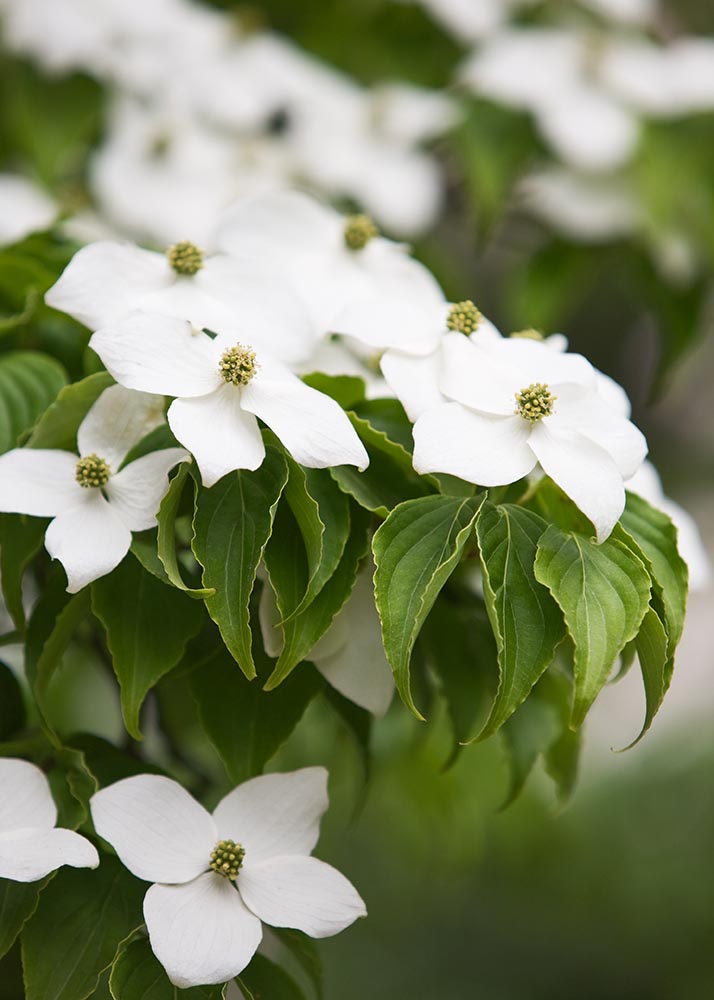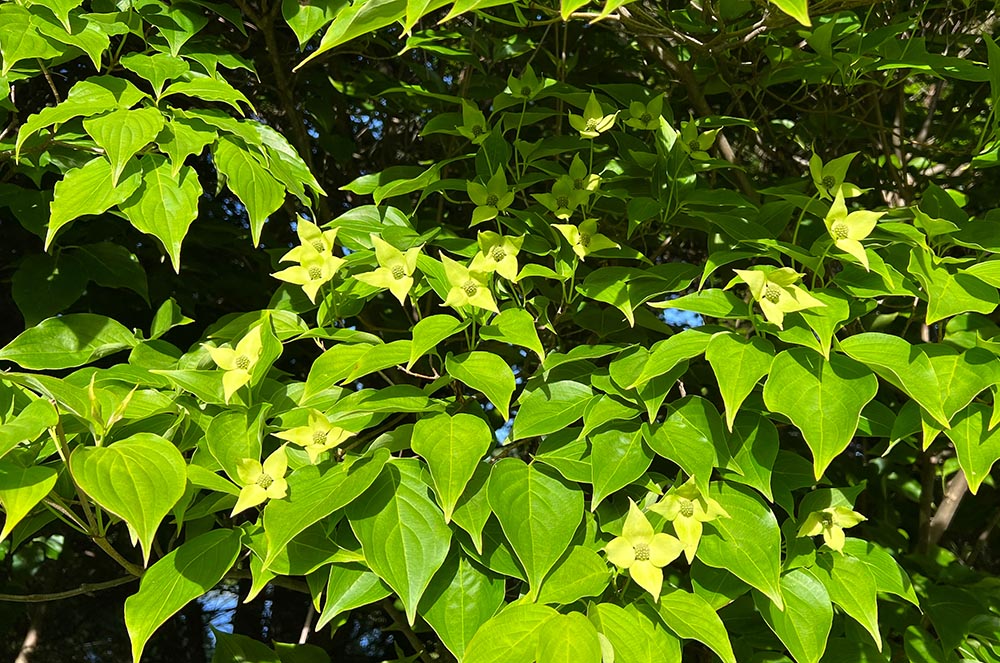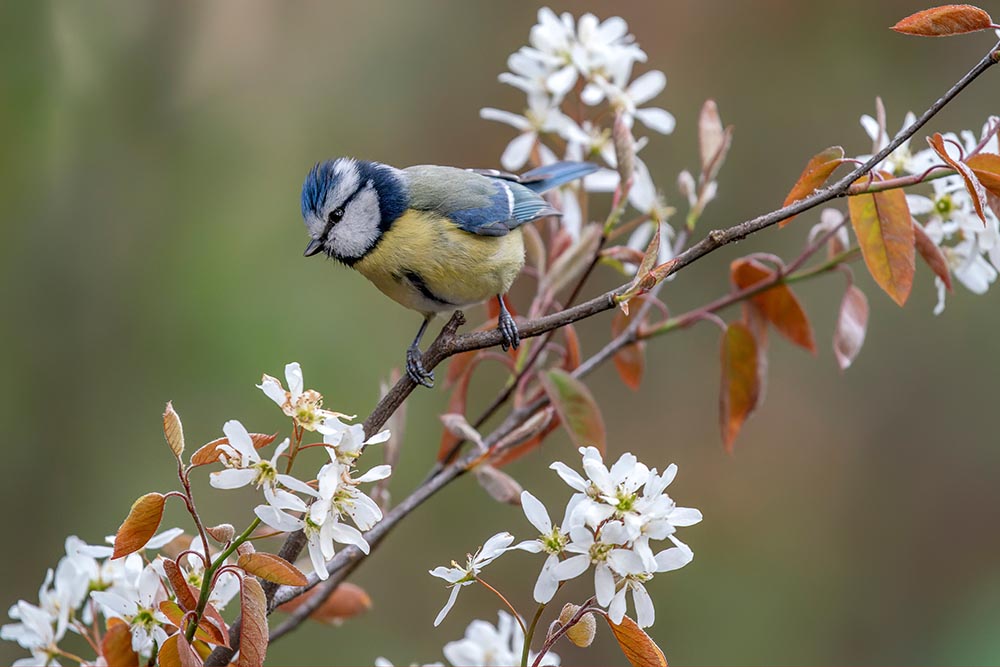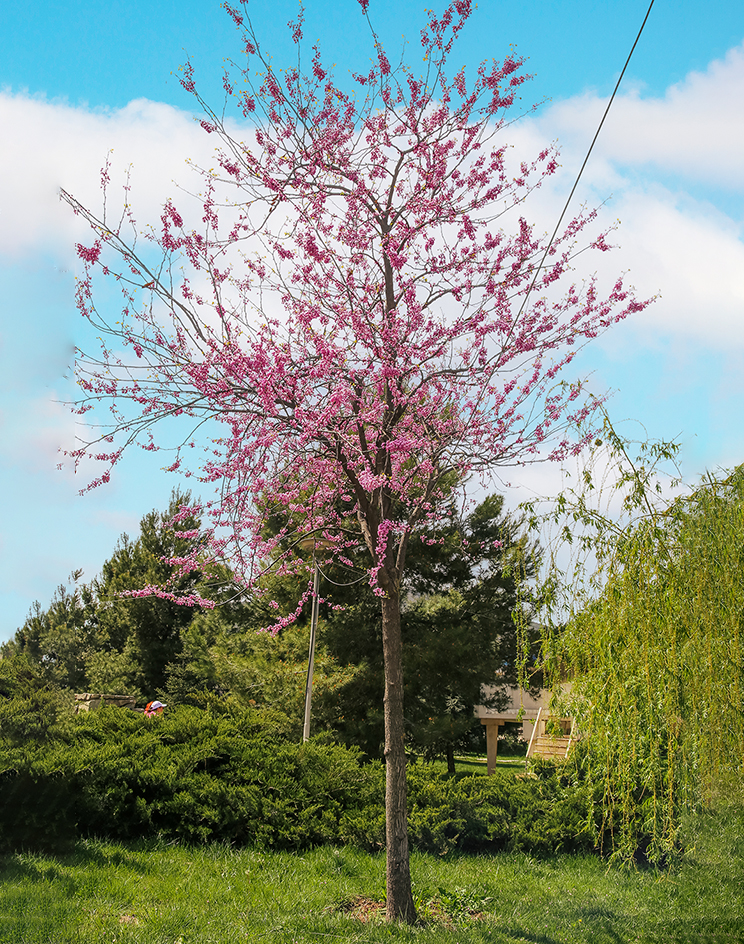Trees for Small Gardens
Add a stunning focal point to a compact green space
With their permanent woody structure, variety of foliage colours, flowers and fruits, trees inject architecture into green spaces, with some offering year-round foliage and others providing spectacular hues of orange or red in autumn. In smaller gardens, trees are sometimes overlooked due to the concern of overcrowding or dwarfing the space. However, there are many smaller varieties, that help to make a space appear larger, as well as medium to larger trees which can be pruned to keep smaller in scale.
As well as providing benefits from an aesthetic point of view, trees are also invaluable to local wildlife—such as birds, for nesting or perching. Trees also benefit our climate by providing oxygen and sequestering carbon, which reduces the amount of carbon dioxide in the Earth’s atmosphere. Additionally, their natural evaporative cooling process helps to absorb the sun’s radiant heat, cooling the areas beneath them, as well as surrounding streets and homes.
What to consider when selecting a tree for a small garden
Size is one of the most important factors when choosing a tree. Trees should make an impact, but not overshadow or dwarf the space. Check the eventual height and how long it takes to reach it, as slow growers will usually allow you to prune regularly to keep the tree on the smaller side. Eventual spread is also an important factor with trees; if space is limited, columnar trees are an excellent option and provide a great focal point.
What season of interest are you looking for? Think about flowering periods, foliage, fruit and bark, as each tree will provide interest at various points of the year. If you only have room for one tree, opt for a variety with multiple seasons of interest.
Trees are either deciduous or evergreen—each with their benefits. Evergreens are brilliant for screening and privacy, as they provide year-round foliage. Deciduous trees on the other hand, provide showstopping autumn colour that you do not get from evergreen trees.
Positioning a tree correctly will help it to thrive; if it’s being planted in close proximity to a property, ensure you’ve looked into safe distances for your chosen tree variety to minimise any risk of potential damage from roots, which could cause subsidence in extreme cases.
Deciduous Tree Recommendations

Cornus kousa white flowers
Cornus kousa
Native to China, Japan and Korea, Cornus kousa—commonly known as Japanese dogwood—is a small, bushy tree that grows to around 7m in height. Cornus kousa provides interest all year round with its blooms, foliage and bark. In summer, it blooms show-stopping clusters of tiny flowers surrounded by white bracts, followed in autumn by an abundance of strawberry-shaped, pink fruits and oval-shaped, bronze and crimson foliage. Cornus kousa has a beautifully unique peeling bark, adding value during the winter months, once its foliage has fallen.
Cornus kousa is great for positioning in the back of a flower bed or border, in full sun or partial shade. Moist, free-draining, neutral to acidic soil is preferred.

Cornus kousa foliage
Malus ‘Pink Perfection’
Another excellent addition to small gardens is Malus ‘Pink Perfection’—commonly known as Crab apple ‘Pink Perfection’. A smaller tree at around 5m, Malus ‘Pink Perfection’ blooms a mass of showy, scented, double pale pink flowers in spring, alongside its green foliage. Its double blooms are unique, as most crab apples bloom single flowers. In autumn, small fruits follow in shades of red, yellow and gold.
Position Malus ‘Pink Perfection’ in full sun for spectacular displays of blossom each year. Partial shade is also tolerated well, along with any moist, well-drained soil. An ideal option for a container, or equally lovely as a feature tree in a spring border.
Betula utilis var. jacquemontii
More commonly known as West Himalayan birch, this hardy tree has an upright form and is tolerant of most conditions. Being a slow-grower—up to around 8m in 20 years—means it can be pruned to keep to an ideal size for compact spaces. Betula utilis var. jacquemontii has medium sized, dark green foliage in spring, alongside yellow-brown catkins. The foliage later transitions to a creamy yellow for autumn, before it falls. Famous for its eye-catching white bark in winter, Betula utilis var. jacquemontii has something to offer for all seasons.
Betula utilis var. jacquemontii is an exquisite feature tree and also works well in multiples. All soil types are suitable and full sun or partial shade positioning are preferred.
Amelanchier lamarckii
Commonly known as Snowy mespilus or Juneberry, Amelanchier lamarckii is a hardy, small tree with an open habit and an eventual height of around 6m. Amelanchier lamarckii has young, copper-bronze foliage which turns fiery red in the autumn months, as well as clusters of white, star-shaped blooms and red-purple berries—an excellent food source for birds. A spreading, vase-shaped crown of fine shoots makes Amelanchier lamarckii a magnificent tree during winter, once its leaves have fallen.
Amelanchier lamarckii prefers full sun or partial shade, although it offers the best autumn colour in sunnier positions. Acidic to neutral, clay or sandy soils will help Amelanchier lamarckii to thrive and it’s great as part of a mixed border, or as a stand-alone potted specimen.

Eurasian Blue Tit (Cyanistes caeruleus) on an Amelanchier lamarckii spring branch
Prunus ‘Amanogawa’
This truly stunning addition to a small garden is commonly known as Cherry ‘Amanogawa’—an ornamental cherry tree with an upright or fastigiate habit. Prunus ‘Amanogawa’ blooms subtly fragrant, soft pink blossom in late spring—popular with pollinators—and green-bronze foliage which transitions to orange and red in autumn.
A sheltered position is vital to help Prunus ‘Amanogawa’ to flourish, in any moist but well-drained soil. Full sun will provide the most showy blooms. Prunus ‘Amanogawa’ works well in borders, underplanted with spring flowering bulbs.

Cercis siliquastrum (Judas tree) in bloom.
Acer palmatum ‘Bloodgood’
Acer palmatum ‘Bloodgood’ is commonly known as Japanese maple ‘Bloodgood’ and one of our most sought-after, purple-leaved varieties. A firm-favourite and growing up to around 4m in height, this tree is an ideal size for smaller gardens with its non-invasive and compact growth. With deep, red-purple, five or seven pointed leaves which later turn a vibrant red, Acer palmatum ‘Bloodgood’ adds fantastic aesthetic value. In spring, Acer palmatum ‘Bloodgood’ blooms small, purple flowers, followed by red fruits during summer.
Acidic or neutral, well-drained soils are ideal for Acer palmatum ‘Bloodgood’, as well as a sheltered spot in full sun or partial shade. Great as a focal point for a small or minimalist garden, and thrives in pots.
Cercis siliquastrum
Cercis siliquastrum, or Judas tree, is a bushy, multi-stemmed tree with a spectacular architectural appearance. Offering exquisite spring colour, Cercis siliquastrum has heart-shaped foliage and impressive clusters of pea-shaped, pink blooms on older stems, with deep purple fruit pods in autumn. Its flowers are rich in pollen and nectar, attracting bees and other pollinators.
Cercis siliquastrum will thrive in full sun or partial shade, in any well-drained soil. Ideal for beds and borders in smaller gardens.
Evergreen Tree Recommendations
Ilex aquifolium ‘Argentea Marginata’
Ilex aquifolium ‘Argentea Marginata’, or Silver-margined Holly, is a medium sized, evergreen tree. This holly species has cream-edged, dark green, spiky foliage all year round, with white flowers in summer and bright red berries in winter. Ilex aquifolium ‘Argentea Marginata’ offers all year round interest and is a fantastic focal point for small green spaces.
A winner amongst the wildlife, Ilex aquifolium ‘Argentea Marginata’ attracts bees, birds and butterflies with its nectar-rich flowers for pollinators, seeds for birds, and shelter for many wildlife species. Ilex aquifolium ‘Argentea Marginata’ does very well in full sun or partial shade, and is tolerant of exposed and coastal situations. Any moist but well-drained soils will allow Ilex aquifolium ‘Argentea Marginata’ to thrive.

Ilex aquifolium ‘Argentea Marginata’ (Holly)
Laurus nobilis
More commonly known as Bay tree, Laurus nobilis is an aromatic, evergreen tree with narrowly ovate, leathery foliage. Offering fantastic year-round ornamental value, this tree is a popular variety and works beautifully in containers when positioned either side of an entrance or on a patio. Laurus nobilis can be clipped to a variety of topiary shapes, including lollipops or cones, to bring living architecture to green spaces.
Laurus nobilis prefers full sun or partial shade in all well-drained soils. In winter, Laurus nobilis can cope in zones 7 to 10. If temperatures are colder than this, they need to be protected during the colder months to prevent damage.
As well as offering great aesthetic value to smaller green spaces, trees provide a number of benefits for our environment, whether you opt for evergreen for year-round foliage, or deciduous for showstopping autumn colour.
Carefully research your desired tree to ensure you can meet its needs, with regards to sun and shade levels, soil types and required space.
Contact our expert G Team if you need advice or more information on the trees we grow and supply, or head to our Tender Tool app to get a quick and easy quote.

